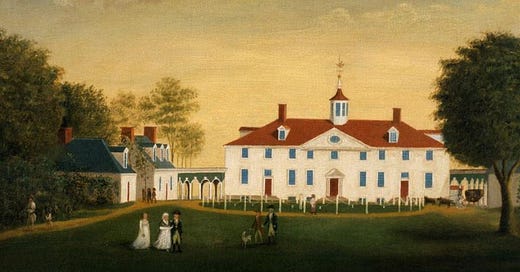TWIH: George Washington's southern tour
Washington considered it important to visit every part of the country. He wanted Americans to know and to form an attachment to their new government.
During this week in 1791, George Washington begins a 3-month tour of the Southern states. As the first President, Washington considered it important to visit every part of the country. He wanted Americans to know and to form an attachment to their new government.
Remember how different things were back then. Today, we are proud of our status as Americans. But our forefathers weren’t there yet. Their first allegiance was to their localities or to their states.
Historian Joseph Ellis describes the task facing Washington during his tenure as President:
“[W]e must recognize that there was no such thing as a viable American nation when [Washington] took office as president, that the opening words of the Constitution (‘We the people of the United States’) expressed a fervent but fragile hope rather than a social reality . . . No republican government had ever before exercised control over a population this diffuse or a land mass this large, and the prevailing assumption . . . [was that] a nation so conceived and so dedicated could not endure. Washington’s core achievement as president, much as it had been as commander in chief of the Continental army, was to transform the improbable into the inevitable.”
Washington’s travels were a part of this effort to bring the nation together. He prioritized his tours of the country and managed to visit all 13 states in less than 2.5 years. Quite a feat, given the difficulty with traveling in the late 1700’s. As he traveled through the states, he took note of the various industries, the agricultural communities, the size and locations of ports, and the possibility of river navigation.
The Southern tour had the potential to be a bit rockier than Washington’s previous tours. One of the states on the tour, North Carolina, had been reluctant to ratify the Constitution and did not do so until after a Bill of Rights had been proposed by the first Congress. Moreover, during the Revolution, there had been pockets of Loyalists in the South. (You may recall from prior posts that the British started a “southern strategy” during the war, partly in reliance on these pockets of Loyalists.)
Nevertheless, the tour went well. Many southerners were proud and excited to see Washington—easily the most admired man of his day. Municipalities threw parades, fired off gun salutes, or even serenaded Washington when he arrived in town. They showed off their Revolutionary battlefields. They brought their children to see the President.
Washington finished his trip and crossed the border back into Virginia on June 4. A diary entry gives his impressions of the citizens that he’d met on the trip: “The manners of the people, as far as my observations, and means of information extended, were orderly and Civil. And they appeared to be happy, contented and satisfied with the genl. governmt. . . .”
Washington arrived at Mount Vernon about a week later. He was finally able to rest at the home that he loved so much.
Sources can always be found on my website, here.





I knew of his tours to all the states and always admired his "grit" in making such long and difficult journeys with all the hazards of travel at that time. This, once again, speaks as to why Washington is so truly the 'Father of Our Country'!
I never tire of hearing about the wisdom and common sense Washington displayed in his efforts to creative a unified nation. God bless him!